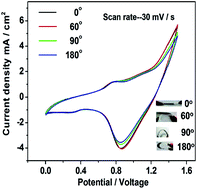Cu superstructures hydrothermally reduced by leaves and derived Cu–Co3O4 hybrids for flexible solid-state electrochemical energy storage devices†
Abstract
Cu–Co3O4 hybrids and activated carbon were employed to fabricate flexible solid-state electrochemical energy storage devices via facile processing. The resulting flexible devices showed a large specific capacitance of 530 mF cm−2 with excellent mechanical flexibility, which offered a maximum volumetric energy density of 0.71 mW h cm−3, and delivered a maximum power density of 88.6 mW cm−3. What's more, the device showed an excellent cycling stability with only ∼5.2% decay after 6000 cycles.


 Please wait while we load your content...
Please wait while we load your content...